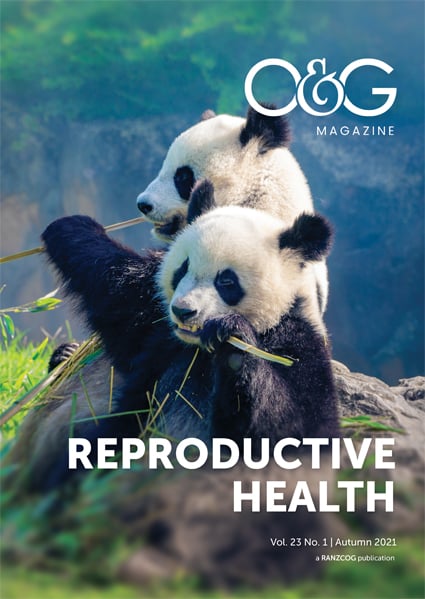Infertility affects over 10% of couples of reproductive age and is ranked the 5th highest serious global disability.1 Based on the World Health Organisation (WHO) definition of infertility, couples who have not conceived after 12 months of regular unprotected intercourse should be referred for clinical assessment and investigation.2 Given the growing trend for women to delay childbearing, the average age for women seeking fertility treatment is increasing with time.3 Therefore, an earlier specialist clinical assessment may be warranted if the woman is aged over 35 years old or if known causes of infertility are present. The initial assessment of the infertile couple involves assessment of duration of infertility, comprehensive history and clinical examination, before requesting appropriate fertility investigations. The causes of infertility can be divided into female factor infertility (35%), male factor infertility (35%), or unexplained infertility (25%).4 Infertility can result from these factors affecting any one or more of these processes: ovulation, fertilisation or implantation.
Ovulation test
Ovulatory dysfunction is one of the leading causes of female factor infertility. Women who are undergoing investigations for infertility should be offered a blood test to measure progesterone during the mid-luteal phase, which is seven days before the expected next period (e.g. day 21 in a 28 day cycle) to confirm ovulation, even if they have a regular menstrual cycle.5 Women with prolonged irregular menstrual cycles should have a progesterone test at day 21 of the cycle and repeated weekly thereafter.6 The use of basal body temperature charts to confirm ovulation does not reliably predict ovulation and is not recommended.7 Urinary luteinising hormone (LH) tests kits are less accurate but are simple, inexpensive and can be performed by patients in their own home. Serum hormone tracking with or without transvaginal ultrasound follicle monitoring is a more reliable option for women with irregular cycles to detect ovulation for timed coitus.8
Endocrine tests
Women with menstrual irregularities should be assessed for thyroid problems, hyperprolactinaemia, pituitary and hypothalamic disorders as part of initial fertility investigations.9 A history of clinical hyperandrogenism may suggest polycystic ovarian syndrome (PCOS) and requires further investigation. This includes free androgen index, free and total testosterone, androstenedione, serum hormone binding globulin, dehydroepiandrosterone sulphate (DHEAS), fasting glucose, insulin, HbA1C, and cholesterol studies. Timely diagnosis and management of PCOS is important as it may result in other antenatal complications aside from infertility. Given that PCOS is a diagnosis of exclusion it is essential to investigate for other conditions such as Cushing’s disease, non-classical adrenal hyperplasia, or an adrenal tumour.10
Baseline hormonal profile
Women should have a baseline hormonal profile at day 2–3 of the menstrual cycle, which includes LH, follicle stimulating hormone (FSH), oestradiol (E2), and progesterone (P4).
A basal gonadotropin level is an indirect maker of ovarian reserve based on feedback inhibition from ovarian steroidogenesis.11 Hypogonadotropic hypogonadism can be caused by weight changes, excessive dieting, exercise or psychosocial stressors, resulting in dysfunction of the hypothalamic- pituitary axis and anovulatory cycles. On the contrary, hypergonadotropic hypogonadism with high FSH and LH and low E2 levels will likely indicate a diminished ovarian reserve or primary ovarian insufficiency. Women with suspected primary ovarian insufficiency should be advised to undertake Fragile–X mutation and karyotype testing to evaluate for Turner’s syndrome.
Uterine abnormalities
A good quality pelvic ultrasound is recommended to evaluate the female pelvic uterine anatomy. Pelvic pathology such as uterine septa, submucosal fibroids or polyps may distort the endometrium, affecting implantation. The presence of an enlarged and fixed uterus, venetian blind shadowing or endometriomas are suggestive of endometriosis or adenomyosis.12 Abnormal ultrasound findings can also facilitate surgical planning and pre-operative counselling, such as features of severe endometriosis such as ‘kissing ovaries’, obliterated pouch of Douglas, bowel tethering or deep infiltrating nodules.13 Given that pelvic abnormalities are more prevalent in the infertile population, there may be a role for utilising 3D imaging, saline sonohysterography or pelvic MRI in this group of women.14
Tubal factors
Damaged or blocked tubes are a known cause of infertility and can result from pelvic inflammatory disease, pelvic adhesions, previous surgery or endometriosis. Couples presenting with infertility should be routinely offered a sexually transmitted infection (STI) screen.15 The uterine cavity and tubal patency can be evaluated using a hysterosalpingo-contrast-sonography (HyCoSy), hysterosalpingogram or hydrotubation during laparoscopy.16 A HyCoSy visualises the spill of contrast out the end of the tubes under ultrasound, where as a hysterosalpingogram takes an X–ray image after contrast medium is passed into the uterus and down the tubes. Women who are thought to have gynaecological pathology should be offered a laparoscopy and tubal dye test so that pelvic pathology and tubal assessment can be performed concurrently.17 These tests should ideally be performed during the follicular phase of the menstrual cycle to prevent disruption to a possible pregnancy.18 There are different advantages and disadvantages of using either of these tests, which can be discussed with a fertility specialist.
Ovarian reserve testing
Ovarian reserve testing is an important component of fertility testing and can be undertaken as a blood test for anti–müllerian hormone (AMH) or measurement of an antral follicle count (AFC) on pelvic ultrasound. The AFC is the total number of follicles in both ovaries between 2–10mm on ultrasound during the early follicular phase. AMH is a peptide growth factor produced in both granulosa and Sertoli cells. In women of reproductive age, AMH declines over time as the ovarian follicular pool decreases with age, reflecting the gradual decline in reproductive capacity until menopause. Given its correlation with small antral follicle count (AFC), it is currently the best available means of assessment of ovarian reserve and prediction of reproductive window or potential. AMH secretion remains fairly stable across the menstrual cycle, with little intra-and inter–cycle variation and therefore can be measured on any day of the cycle.19 It is worth mentioning that AMH is not a marker or oocyte quality or fecundity, but a prognostic marker for an expected outcome in assisted reproductive technology (ART). Both serum AMH and AFC can provide good predictive accuracy of ovarian response to controlled ovarian stimulation and can be used to individualise ovarian stimulation protocols for women undergoing ART.20
Semen analysis
A semen analysis should be conducted as part of the initial assessment of an infertile couple and compared to the WHO reference values, even in the presence of known female factor infertility.21 The man should observe the 2–5 day period of abstinence prior to producing a sperm sample. A normal semen analysis will normally exclude male factor infertility.22 In the event of an abnormal semen analysis, a repeat confirmatory test should be undertaken three months after modifying lifestyle factors to allow completion of the spermatozoa cycle.23 Grossly abnormal tests (severe oligospermia or azoospermia) will warrant a repeat test as soon as possible and further investigations to exclude genetic, anatomical, structural, congenital, hormonal, endocrine or infective causes. These may include hormonal profile (LH, FSH, oestradiol, testosterone), inhibin, prostate sensitive antigen (PSA), STI screening, thyroid function, prolactin, karyotype, Y-chromosome microdeletion, cystic fibrosis gene mutation testing, sperm DNA integrity testing (sperm chromatin structure assay–SCSA), ++anti–sperm antibodies, post ejaculatory urine analysis, and/or a scrotal ultrasound.24 A referral to a urologist may also be required to optimise sperm production for assisted reproduction.
Karyotype
Routine karyotype testing in a couple presenting with infertility is not recommended.25 A couple presenting with infertility may be advised to perform karyotype testing as a second line test. Where there is a severe deficit in semen quality or a history if recurrent miscarriages, karyotype should be offered.26 13.7% of men with azoospermia and 4.6% of men with oligospermia are found to have an abnormal karyotype.27 Couples who are undergoing karyotype testing should be offered genetic counselling regarding the possible genetic abnormalities that may be detected.28
Preconception and genetic carrier screening
It is good practice to perform serological testing for women trying for a pregnancy, including varicella, rubella, syphilis, Hepatitis B, Hepatitis C, and HIV serology.29 This allows women to undertake appropriate vaccination prior to embarking on a pregnancy or referral to infectious diseases, as appropriate. Women should also have blood group and antibody testing to exclude the presence of undetected blood group antibodies which may implicate the unborn fetus. Genetic carrier screening should also be offered to all couples trying to conceive, especially in high-risk ethnic populations who have a higher likelihood being carriers of genetic disorders such as cystic fibrosis, Tay-Sachs disease, spinal muscular atrophy and thalassemia.30
Conclusion
A complete fertility assessment includes evaluation of ovulation, ovarian reserve, pelvic anatomy, tubal patency, basal hormones, endocrine function, semen analysis and pre-conceptual screening. A comprehensive fertility assessment is key to determining the underlying causes of infertility and provide a basis for personalised counselling, management and fertility care for the couple presenting with infertility.
References
- World Health Organisation. Infertility Definitions and Terminology. WHO 2021. Available from: www.who.int/teams/sexual-and-reproductive-health-and-research/key-areas-of-work/fertility-care/infertility-definitions-and-terminology.
- World Health Organisation. Infertility Definitions and Terminology. WHO 2021. Available from: www.who.int/teams/sexual-and-reproductive-health-and-research/key-areas-of-work/fertility-care/infertility-definitions-and-terminology.
- Quinn F. We are having trouble conceiving. Australian Family Planning. 2005;(3):107-10.
- Fertility assessment and treatment for people with fertility problems. NICE Clinical Guideline 2013. Updated 2017. Available from: www.nice.org.uk/guidance/cg156/evidence/full-guideline-pdf-188539453.
- Fertility assessment and treatment for people with fertility problems. NICE Clinical Guideline 2013. Updated 2017. Available from: www.nice.org.uk/guidance/cg156/evidence/full-guideline-pdf-188539453.
- Fertility assessment and treatment for people with fertility problems. NICE Clinical Guideline 2013. Updated 2017. Available from: www.nice.org.uk/guidance/cg156/evidence/full-guideline-pdf-188539453.
- Fertility assessment and treatment for people with fertility problems. NICE Clinical Guideline 2013. Updated 2017. Available from: www.nice.org.uk/guidance/cg156/evidence/full-guideline-pdf-188539453.
- Quinn F. We are having trouble conceiving. Australian Family Planning. 2005;(3):107-10.
- Fertility assessment and treatment for people with fertility problems. NICE Clinical Guideline 2013. Updated 2017. Available from: www.nice.org.uk/guidance/cg156/evidence/full-guideline-pdf-188539453.
- Hunt S, Vollenhoven B. Assessment of female fertility in the general practice setting. Australian Journal of General Practice. 2020;(6):49.
- Hunt S, Vollenhoven B. Assessment of female fertility in the general practice setting. Australian Journal of General Practice. 2020;(6):49.
- Hunt S, Vollenhoven B. Assessment of female fertility in the general practice setting. Australian Journal of General Practice. 2020;(6):49.
- Hunt S, Vollenhoven B. Assessment of female fertility in the general practice setting. Australian Journal of General Practice. 2020;(6):49.
- Committee on Gynecologic Practice, American Society for Reproductive Medicine. ACOG Committee Opinion, No.781. Infertility Workup for the Women’s Health Specialist. 2019. Available from: www.acog.org/-/media/project/acog/acogorg/clinical/files/committee-opinion/articles/2019/06/infertility-workup-for-the-womens-health-specialist.pdf.
- Fertility assessment and treatment for people with fertility problems. NICE Clinical Guideline 2013. Updated 2017. Available from: www.nice.org.uk/guidance/cg156/evidence/full-guideline-pdf-188539453.
- Fertility assessment and treatment for people with fertility problems. NICE Clinical Guideline 2013. Updated 2017. Available from: www.nice.org.uk/guidance/cg156/evidence/full-guideline-pdf-188539453.
- Fertility assessment and treatment for people with fertility problems. NICE Clinical Guideline 2013. Updated 2017. Available from: www.nice.org.uk/guidance/cg156/evidence/full-guideline-pdf-188539453.
- Quinn F. We are having trouble conceiving. Australian Family Planning. 2005;(3):107-10.
- Broer S, Broekmans F, Laven J, Fauser B. Anti-Mullerian hormone: Ovarian reserve testing and its potential clinical implications. Human Reprod Update. 2014;20(5):688-701.
- Oh S, Choe S, Cho Y. Clinical application of serum anti-Mullerian hormone in women. Clin Exp Reprod Med. 2019;46(2):50-9.
- Quinn F. We are having trouble conceiving. Australian Family Planning. 2005;(3):107-10.
- Quinn F. We are having trouble conceiving. Australian Family Planning. 2005;(3):107-10.
- Fertility assessment and treatment for people with fertility problems. NICE Clinical Guideline 2013. Updated 2017. Available from: www.nice.org.uk/guidance/cg156/evidence/full-guideline-pdf-188539453.
- Katz D, Teloken P, Shoshany O. Male infertility – The Other Side of the Equation. Australian Family Physician. 2017;(9):641-6.
- Committee on Gynecologic Practice, American Society for Reproductive Medicine. ACOG Committee Opinion, No.781. Infertility Workup for the Women’s Health Specialist. 2019. Available from: www.acog.org/-/media/project/acog/acogorg/clinical/files/committee-opinion/articles/2019/06/infertility-workup-for-the-womens-health-specialist.pdf.
- Fertility assessment and treatment for people with fertility problems. NICE Clinical Guideline 2013. Updated 2017. Available from: www.nice.org.uk/guidance/cg156/evidence/full-guideline-pdf-188539453.
- Fertility assessment and treatment for people with fertility problems. NICE Clinical Guideline 2013. Updated 2017. Available from: www.nice.org.uk/guidance/cg156/evidence/full-guideline-pdf-188539453.
- Fertility assessment and treatment for people with fertility problems. NICE Clinical Guideline 2013. Updated 2017. Available from: www.nice.org.uk/guidance/cg156/evidence/full-guideline-pdf-188539453.
- RANZCOG. Pre-pregnancy Counseling. 2017. Available from: https://ranzcog.edu.au/RANZCOG_SITE/media/RANZCOG-MEDIA/Women%27s%20Health/Statement%20and%20guidelines/Clinical-Obstetrics/Pre-pregnancy-Counselling-(C-Obs-3a)-review-July-2017_1.pdf?ext=.pdf.
- Hunt S, Vollenhoven B. Assessment of female fertility in the general practice setting. Australian Journal of General Practice. 2020;(6):49.







Leave a Reply